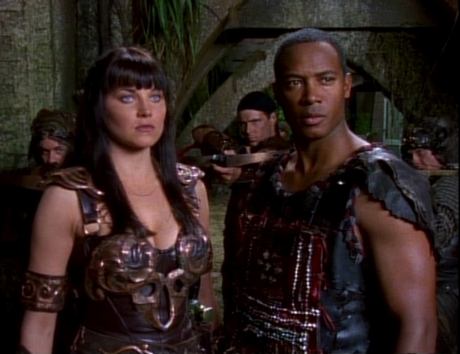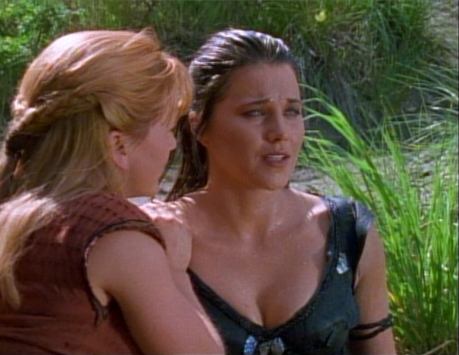| We've spent a lot of time at the beginning of Xena and Hercules, but that's because these shows contain a lot of baggage that will be unpacked in future seasons. Sins of the Past contains other clues, such as the name of Xena's father, not included in its final version, but present in the original teleplay. In one version, Xena's father is Nelo, a female name taken from the myth of the Danaids01, but applied to a male character; later, his name will be taken from the myth of Orestes. These changes reveal further patterns which are beyond the scope of this essay, but the few items we'll examine will be enough to establish a patterned framework. The next episode, Chariots of War, is a significant one, but here we'll only note that the tavern scene reprises the Black Orpheus scene in the tavern Xena and Gabrielle visit; it's the first time it's used on Xena, Warrior Princess, but won't be the last. In the following Cradle of Hope, we see more signs of Dionysus: They visit the kingdom of Lerna, a name taken from the lake Dionysus used to enter the underworld. Xena's look-alike, Diana, most likely takes her name from The Greek Myths, ch. 27, the chapter on Dionysus: "Diana in the leaves green", which was one aspect of the Moon-goddess. This chapter tells us that Dionysus had a hero's upbringing, which meant that he was brought up in disguise: he was given by Zeus to King Athamas of Orchomenus and his wife Ino, who raised him as a girl to protect him from Hera. The child of this episode was found in a basket in a river, much like the story of Moses, but this story of floating a baby down a river is common in myth, and the intended reference for this image is almost certainly not Moses, but to another play by Euripides: "Ion," which ties in the myth of Pandora as well. We can expect to find a reference to The Cyclops, and we have it when we're told the king's advisor, searching for this child who will one day take the king's throne is named "Nemos", sounding very similar to Ulysses' disguised name, "Nemo," meaning "No one." The purpose of giving him this name? Probably to show that, like Ulysses, he's a crafty one, but mainly it's significant because it tells us the writers are sticking close to their sources. 
Death in Chains picks up from this episode, working in another Euripides' play, Alcestis, about a man who can live forever as long as someone will agree to sacrifice their lives for him. When his time comes, his wife agrees to make the sacrifice. In the myth of Sisyphus, he chains Thanatos (Death), threatening Hades' power. Thanatos, a male god, does not appear in this episode, substituted instead with "Celesta", an invented female goddess, but this is probably to reflect the influence of Euripides: Celesta is virtually an anagram for Alcestis, and like the title character of Euripides' play, Celesta is a tragic female. This episode connects The Path Not Taken to Mortal Beloved, which appears several episodes later on. Mortal Beloved gives us more Dionysus references, showing us the lake where he descends, into which Xena submerges while Gabrielle waits by its shores. This image of Gabrielle waiting for her friend by the empty lake throughout the episode impresses viewers as a significant moment in their friendship, which it is, but the most significant moment is at the very end, when Xena returns and sits by her side:  Hooves and Harlots here represent centaurs and Amazons, and that combination fascinated Rob Tapert from the beginning. The "external structure" that's beyond the scope of this essay firmly connects this episode with Sins of the Past and Is There A Doctor In The House, but the Dionysus connection we're exploring goes beyond that. There are no male Amazons, and as Steve Sears, the author of this episode, has said there are no female centaurs, a fact established early on and always consistent02. He's explained to fans his own theory why this is the case, involving dominant genes and such, but it's obviously a justification after the fact, based on a decision already made. The real question is, why is it important for the writers of Xena that there aren't any female centaurs? Clearly it's because this is a war of the sexes, implicit throughout Xena, and engrained in its subtext of patriarchal overthrow as described in The Greek Myths. This point is made explicit when an Amazon tells Gabrielle that history is written by men, with women's acquiescence. The Amazons we see are the barbarians of the myths, but more like the secret societies described by Graves and Eliade. One such secret society in ancient Greece is the Thesmophoria, a festival attended only by women, who commemorated the lack of rain that resulted from Demeter's mourning for her abducted daughter, Persephone. You'll recall the myth of Cyane, mentioned previously: no doubt this is one reason why her name is the title for the Xenaverse Amazon queens; it reflects that the all-female warrior society on the show is derived from the Thesmophoria. But why make that connection to the festival in the first place? The answer again, is most likely Euripides! His play, Helen, is thought by some to have originally been written for the secretive women's festival, and Aristophanes wrote his play, Thesmophoriazusae, with Euripides as the star buffoon. He has the playwright of Helen trying to sneak into the festival, where no men are allowed, in order to discover what they're plotting to do to him for revealing their secrets to men, in the form of his insightful dramas about women. Head writer R.J. Stewart has said that Helen was a key influence on his approach to Xena, and the writers' obvious familiarity with Aristophanes' play would no doubt help inspire their depiction of women holding onto their power in a patriarchal society. The conflict between centaurs and Amazons is based on a pattern that will manifest elsewhere, under different names, so we'll talk more about that, including the Thesmophoria, when we get to the later Amazon episodes. In Hooves and Harlots we can also see influences from the Dionysiac dancing in The Bride With White Hair, which matches descriptions from The Greek Myths and The Bacchae. In the latter play, we hear about the superpowers of the maenads; how they battle soldiers with sticks and take on animal characteristics in the forests; at one point they suckle beasts, indicating a relationship between the women and beasts, so it's no surprise we have a show about an Amazon and a centaur forming a relationship, and later on, having a centaur child. The relationship of Xena to the Amazons has always been as an outsider: she may be a bacchae in spirit, but she's also Orpheus/Dionysus, the male who presides over them without being part of them...and eventually is their sacrificial figure. That's not the literal plot of Hooves and Harlots, of course; the symbolic nature of these relationships rise above the plot of the episode, and connect them to the larger arc. |